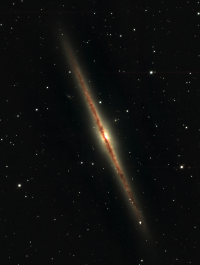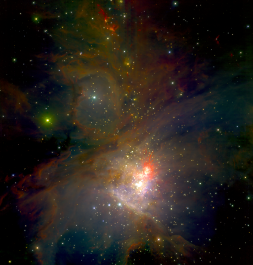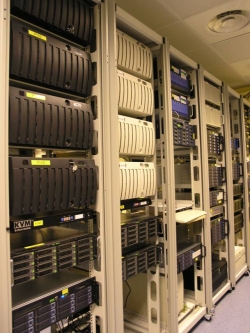The TERAPIX data centre is processing WIRCam images for the scientific community.
WIRCam stands for "Wide field Infrared Camera". It is the latest wide-field imaging facility available at the Canada-France-Hawaii Telescope (CFHT), an international astronomical telescope facility which sits at the summit of the mountain of Mauna Kea (4200m), in Hawaii. CFHT is funded and operated by the French Institut des Sciences de l'Univers (INSU) of the Centre National de la Recherche Scientique (CNRS) , the National Research Council of Canada (NRC) and the University of Hawaii.
The WIRCam instrument is equipped of several narrow and broad band infrared filters that provide scientific wide field images in the wavelength range between 1100 to 2500 nanometers. WIRCam is one of the widest near-infrared mosaic detectors in the world, though its field of view is only 1/9th of Megacam. However, because of the brightness of the sky at longer wavelengths, near infrared cameras saturate much faster than conventional optical CCD detectors and force astronomers to shorten considerably individual exposure times. Therefore, in order to get the same depth as optical images, the number of exposures must be 10 times larger than for CCD observations.
The amount of data produced by WIRCam will eventually be as large as Megacam and it is expected the image processing of these data will be as demanding as wide field optical imaging. TERAPIX provides its technical expertise and its computing ressources to assist the CFHT astronomical community.
 | The edge-on galaxy NGC891.
This image is a composite Y, J and Ks (near infrared broad band filters centered at 1100, 1200 and 2150 nanometers, respectively) image, for a total of about 10 minutes of WIRCam observation at CFHT. |
| © 2006 Canada-France-Hawaii Telescope Corporation, C. Marmo/Terapix. | |
| Download the full resolution .jpg image. (385KB) |
| M42, the Orion Nebula.
This image is a composite Y, H (broad band filters centered at 1100 and 1400 nanometers) and a narrow band H2 image (centered at 2100 nanometers, but with a bandpass ten times narrower than the Ks filter). The total WIRCam exposure time is about 30 minutes. |  |
| © 2006 Canada-France-Hawaii Telescope Corporation, C. Marmo/Terapix. | |
| Download the full resolution .jpg image. (3MB) |
These examples of three-colour composite images have been generated at TERAPIX data centre using observations taken with the WIRCam mosaic at the Canada-France-Hawaii Telescope.
Astronomical objects are often obscured by interstellar dust such as those found in star forming regions or in dusty torii around the centre of active galactic nuclei. The ultra-violet and visible light emitted inside dust regions is then absorbed by dust that eventually re-emit their energy as infrared light. In contrast, near infrared light is also much less absorbed by dust and can propagate without being attenuated. Using near infrared detectors, like WIRCam, astronomers can then explore these "mysterious" heavily obscured objects located in the centre of galaxies or inside nebulae, or observe the distribution of dust in the universe. This is the case for the bulge of NGC891 (almost completely invisible in optical images) and for the regions of star formation in M42 (the Orion Nebula).
Astronomical observations with WIRCam has started already and large programs will begin shortly. Complementary near infrared of large optical surveys, like the on going Canada-France-Hawaii-Telescope Legacy Survey (CFHTLS) , will be soon needed. CFHT astronomers will then be able to get wide field images of the obscured universe or the very high redshift universe with exquisite detail.
A large amount of data will be produced in the coming years at CFHT, either for dedicated scientific objectives of individual astronomers or for more broad astronomical usages such as "legacy" surveys. As for wide field optical mosaic cameras, like CFHT/Megacam or CFHT/CFH12k, the TERAPIX data centre offers help, assistance and processing facilities to all astronomers planning observations with WIRCam. Astronomers can ask TERAPIX to process their own images.
| The current TERAPIX/WIRCam pipeline is now producing and delivering WIRCam data. After initial pre-processing at CFHT and archiving at the Canadian Astronomy Data Centre (CADC) each image is transferred to the TERAPIX data centre located at the Institut d'Astrophysique de Paris (IAP). Prior to stacking all images together to improve the detection of faintest objects, TERAPIX determines the relative position of each pixel on the sky with extreme precision (about one tenth of pixel size). Using this "astrometric calibration", images are then carefully re-centered, reprojected on the sky, then combined.
Because of the high and fluctuating thermal infrared emission of the atmosphere, processing near infrared demands special attention and more sophisticated algorithms than optical imaging. |
At the end of the pipeline, TERAPIX produces catalogues which record the total flux, the surface brightness, the position and the shape of each source detected in the final image. A series of plots, images and meta-data are also delivered to each user, so that they can assess data quality.
See also: ![]() this page in French
this page in French ![]() CFHT WIRCam Press Release.
CFHT WIRCam Press Release. ![]() CNRS-INSU Communique de Presse (in french).
CNRS-INSU Communique de Presse (in french).
TERAPIX is funded by the French national research agency (CNRS/INSU), the Programme National de Cosmologie (PNC), the Service d'Astrophysique of the Commissariat à l'Energie Atomique (CEA/SAp), the Institut d'Astrophysique de Paris (IAP), and the European FP5 RTD contracts "Astrowise" and "AVO" (Astrophysical Virtual Observatory).



